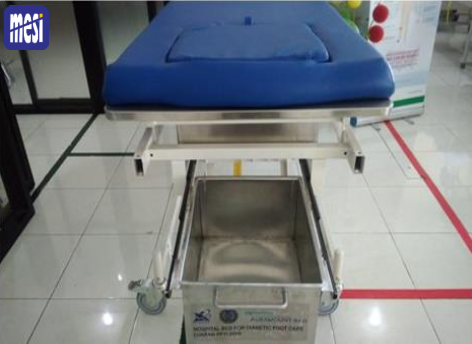Hospital Bed for Diabetes Care: An Invention to Support Professional and Hygienic Nursing Practice
Main Article Content
Abstract
Appropriate diabetes mellitus (DM) wound care requires safe and comfortable space and facilities for patients and nurses. However, the existing hospital bed for DM has not supported the safety and comfort for nurses to serve patients, including the problem of liquid waste and some DM wounds emit a foul smell. Therefore, a hospital bed for DM wound care was designed in this research to support professional, efficient, ergonomic, and safe nursing practice. Multidisciplinary collaboration by engineers, wound nursing practitioners, and industry is carried out in this project. The level of risk of work disturbances was evaluated using a rapid entire body assessment (REBA), the level of risk of contamination was evaluated by a qualitative exposure assessment, and the level of comfort was measured using the visual analog method. Trials on 30 respondents consisting of 28 nurses and 2 doctors indicated that they were comfortable working with the new design of this prototype with lower risk.
Downloads
Article Details

This work is licensed under a Creative Commons Attribution-NonCommercial 4.0 International License.
References
[2] Sibbald, R. G. and Elliott, J. A. and Persaud-Jaimangal, R. and Goodman, D. G. and H. Laurie and Armstrong, and R. and M. Catherine and Coelho, Sunita and Xi, Nancy and Evans, “Wound Bed Preparation 2021,” Advances in Skin & Wound Care, vol. 34, no. 4, pp. 183–195, 2021, doi: 10.1097/01.ASW.0000733724.87630.d6.
[3] A. Coskun Beyan, B. Dilek, and Y. Demiral, “The effects of multifaceted ergonomic interventions on musculoskeletal complaints in intensive care units,” International journal of environmental research and public health, vol. 17, no. 10, p. 3719, 2020, doi: 10.3390/ijerph17103719.
[4] K. Buckheit and J. Ostendorf, “Ergonomics and Nursing in Hospital Environments,” Workplace Health & Safety, vol. 61, no. 10, pp. 429–439, 2013, doi: 10.1177/216507991306101003.
[5] R. Samad, S. Yusuf, A. Andriani, and E. Erfina, “Nurses’ perspectives on diabetic foot ulcer’s odor: A qualitative study,” Enfermería Clínica, vol. 30, pp. 300–303, 2020, doi: 10.1016/j.enfcli.2019.07.107.
[6] G. Lemire et al., “Hospital Bed,” US20070174965A1, 2006.
[7] M. M. Cremasco, A. Giustetto, F. Caffaro, A. Colantoni, E. Cavallo, and S. Grigolato, “Risk assessment for musculoskeletal disorders in forestry: A comparison between RULA and REBA in the manual feeding of a wood-chipper,” International Journal of Environmental Research and Public Health, vol. 16, no. 5, 2019, doi: 10.3390/ijerph16050793.
[8] USDA/FSIS and EPA, “Microbial Risk Assessment Guideline: Pathogenic Organisms with Focus on Food and Water,” 2012.
[9] K. Kolcaba, “Comfort Theory and Practice: A Vision for Holistic Health Care and Research,” Clinical Nurse Specialist: January-February 2005, vol. 19, no. 1, p. 49, 2004, doi: 10.1097/00002800-200501000-00014.
[10] M. Boniol, M. Mcisaac, L. Xu, T. Wuliji, K. Diallo, and J. Campbell, “Gender equity in the health workforce: Analysis of 104 countries,” 2019. [Online]. Available: https://apps.who.int/iris/handle/10665/311314.
[11] N. O. C. Onyemaechi, G. E. Anyanwu, E. N. Obikili, O. Onwuasoigwe, and O. E. Nwankwo, “Impact of overweight and obesity on the musculoskeletal system using lumbosacral angles,” Patient Preference and Adherence, vol. 10, pp. 291–296, 2016, doi: 10.2147/PPA.S90967.
[12] S. C. Wearing, E. M. Hennig, N. M. Byrne, J. R. Steele, and A. P. Hills, “Musculoskeletal disorders associated with obesity: A biomechanical perspective,” Obesity Reviews. 2006, doi: 10.1111/j.1467-789X.2006.00251.x.
[13] A. Anandacoomarasamy, I. Caterson, P. Sambrook, M. Fransen, and L. March, “The impact of obesity on the musculoskeletal system,” International Journal of Obesity. 2008, doi: 10.1038/sj.ijo.0803715.
[14] Y. Mehta et al., “Guidelines for prevention of hospital acquired infections,” Indian Journal of Critical Care Medicine, 2014, doi: 10.4103/0972-5229.128705.
[15] OSHA, “Ergonomics : The Study of Work,” U.S. Department of Labor, 2000, doi: http://dx.doi.org/10.1097/AUD.0b013e31820fca23.

